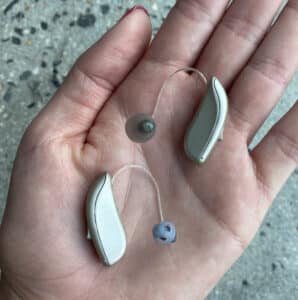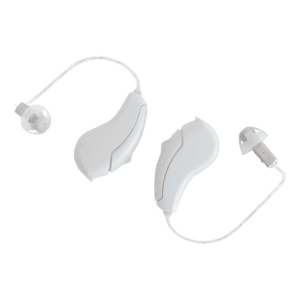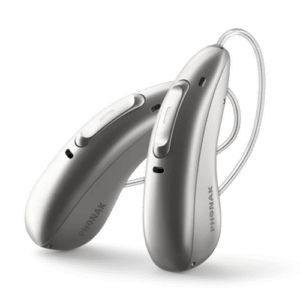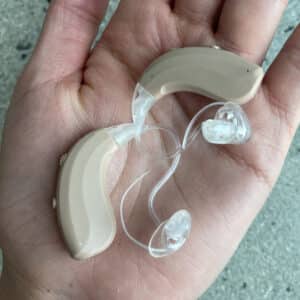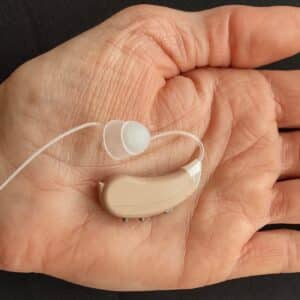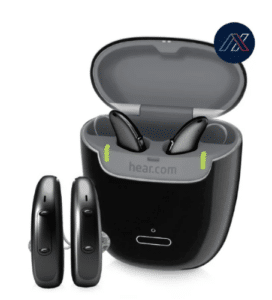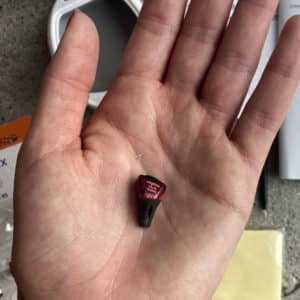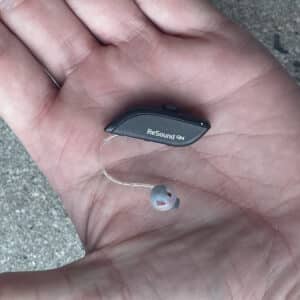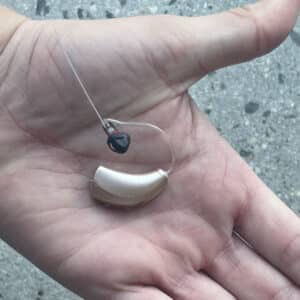Jabra Enhance earns “Our Top Pick” for the company’s combination of quality, over-the-counter devices and a commitment to ongoing customer service that includes support from an audiology team (specialists trained to treat hearing loss) if you purchase the premium package. All this together makes Jabra Enhance one of the best OTC hearing aids on the market.

1,841,585 people helped this year
A quick look at the best hearing aids
- Jabra Enhance: Most Popular
- Audien: Most Affordable
- Phonak: Best for Severe Hearing Loss
- MDHearing: Most Feature Options
- Eargo: Best Invisible Fit
- Lexie: Most User-Friendly
- hear.com: Best In-Home Care
Whether you’re having dinner with friends or watching television at home, hearing loss can get in the way of your quality time, disrupt your ability to communicate and gather information effectively, and lessen your confidence in social settings. But the right hearing aid can enhance your hearing, and even protect your brain from cognitive decline, [1] National Institutes of Health. Hearing Aids Slow Cognitive Decline in People at High Risk. Found on the internet at: https://www.nih.gov/news-events/nih-research-matters/hearing-aids-slow-cognitive-decline-people-high-risk so you feel more comfortable and confident in all areas of your life. Our Reviews Team compared the best hearing aids for 2024 based on features, pricing, and customer care to help you make the right decision for your needs.
For our Reviews Team’s recommendations on the most budget-friendly hearing aids of the year, visit our list of the most affordable hearing aids we researched and tested.
How we research and review hearing aids

We only recommend hearing devices that we think will have a positive impact for our readers, so we began our testing process by reviewing hearing aid research. We also consulted with audiologists and geriatric care experts to better understand the research, the needs of people with hearing loss, and the hearing aid brands and models on the market.
We read thousands of hearing aid reviews on trusted third-party sites such as Better Business Bureau (BBB) and Trustpilot to understand customers’ experiences and where they think hearing aids are falling short. Next, we conducted a survey to discover what people love about their hearing aids, what features they use, and what their biggest challenges are.
We focused on brands that:
- Are widely available
- Have a range of prices
- Treat different types of hearing loss
- Offer a variety of features for different hearing concerns
Any time we recommend a hearing aid brand, we have our selections medically reviewed by an audiologist to examine the company, find the best model, and ensure every hearing aid on our list is appropriate for our readers’ needs.
Read more about our hearing aids review methodology.
The best hearing aid brands, as of April 2024
Best hearing aids of 2024
Brands that didn’t make our best hearing aids list
Our Reviews Team vetted the top hearing aids through careful research and testing, but there are many other brands on the market. While Go Hearing, Otofonix, Rexton, and Unitron are close contenders for our best hearing aids designation, here’s why these brands and others didn’t make our current list.
- Go Hearing: For $199–$499 per pair, Go Hearing OTC hearing aids are a close runner-up to our list because of the brand’s competitive prices and battery life. The brand’s Go Prime discreet ITE model has a long rechargeable battery life of 30 hours and a wireless case that can fully charge your hearing aids up to six times for when you’re on the go, earning a place on our best rechargeable hearing aids roundup.
- Otofonix: Otofonix OTC hearing aids range between $248–$795 per pair. Otofonix hearing aids with rechargeability and Bluetooth connectivity for wireless adjustments tend to be priced higher, with costs varying between models. While Otofonix is relatively low-cost compared to other hearing aid brands on our list, it only offers one BTE style across all six models, while brands like MDHearing offer more versatility at a similar price range of $299–$699 per pair.
- Rexton: You can find Rexton prescription hearing aids at Costco starting at $1,599.99 per pair, or you can purchase them through your audiologist. Offering all hearing aid styles and 14 different models, the brand offers a wide selection of rechargeable devices that treat mild to profound hearing loss. Most Rexton hearing aids offer advanced technology that adapts to your environment to enhance sound and clarify speech, but brands like Starkey have an edge over Rexton with their more advanced, award-winning learning software.
- Unitron: Unitron prescription hearing aids are manufactured by Sonova, the same manufacturer that produces the well-known Phonak hearing aids included in our top picks. This brand offers RIC, BTE, and ITE styles with Bluetooth and rechargeable options that cost from $2,000–$6,000, depending on the model. Although Unitron and Phonak devices closely resemble each other, Phonak has a wider range of accessories and more advanced noise canceling technology.
- Nano: Nano rechargeable OTC hearing aids cost $297–$597 per pair and come in BTE and CIC styles. The Sigma+ ($597) is the only model that offers Bluetooth connectivity to an app for wireless adjustments. This brand’s price range is lower than most, but buyer beware: Nano was involved in a lawsuit over false advertising and misleading business practices for “implying its products are approved by the FDA when they are not” and unlawfully marketing its products for children. Read more in Vermont’s Attorney General 2023 press release, and check out our Nano Hearing Aids Review.
What is a hearing aid?
A hearing aid is an electronic device designed to improve your hearing in both noisy and quiet environments. Hearing aids work by magnifying sound frequencies entering the ear.
Hearing aids have one or two microphones to pick up sound, an amplifier to make the sound louder, and a receiver to transmit the amplified sound to the middle ear. Beyond the basic operating parts, companies offer hearing aid devices with different designs, features, and technology.
How do hearing aids work?
Hearing aids are worn in or behind your ear. They’re designed to make certain sound frequencies louder to improve your hearing and speech comprehension. A microphone inside the hearing aid first picks up sounds, which are then analyzed and converted to electrical signals. These signals are then sent to the amplifier.
The now amplified sounds are sent to the speaker or receiver, which are transmitted to the inner ear by a tube or thin wire. Once in the inner ear, the sounds are transformed into electrical impulses, which your brain turns into sound.
Digital vs. analog hearing aids
Hearing aids are available in analog or digital. Although digital is the most common type of device, a few companies still carry analog hearing aids. The difference between analog and digital devices comes down to the type of electronics used. Both devices convert sound waves, but the process used sets each type apart. [4]U.S. Food and Drug Administration. Types of Hearing Aids. Found on the internet at https://www.fda.gov/medical-devices/hearing-aids/types-hearing-aids
With an analog hearing aid, you will experience amplification with all sounds, including noise and speech. In other words, they make continuous sound waves louder. Analog hearing aids require the user to change settings when in different environments, but some people feel that analog devices provide a more natural hearing experience.
Digital hearing aids convert sound waves to digital signals, providing the clearest hearing possible. These devices are capable of clearing out background noise, reducing feedback, and helping you focus on the sounds and voices you want to hear. Digital hearing aids also offer more complex programming, which allows you to process sounds more selectively.
Types of hearing aids
The five main types of hearing aids have their own pros and cons.
Completely-in-the-canal (CIC) hearing aid
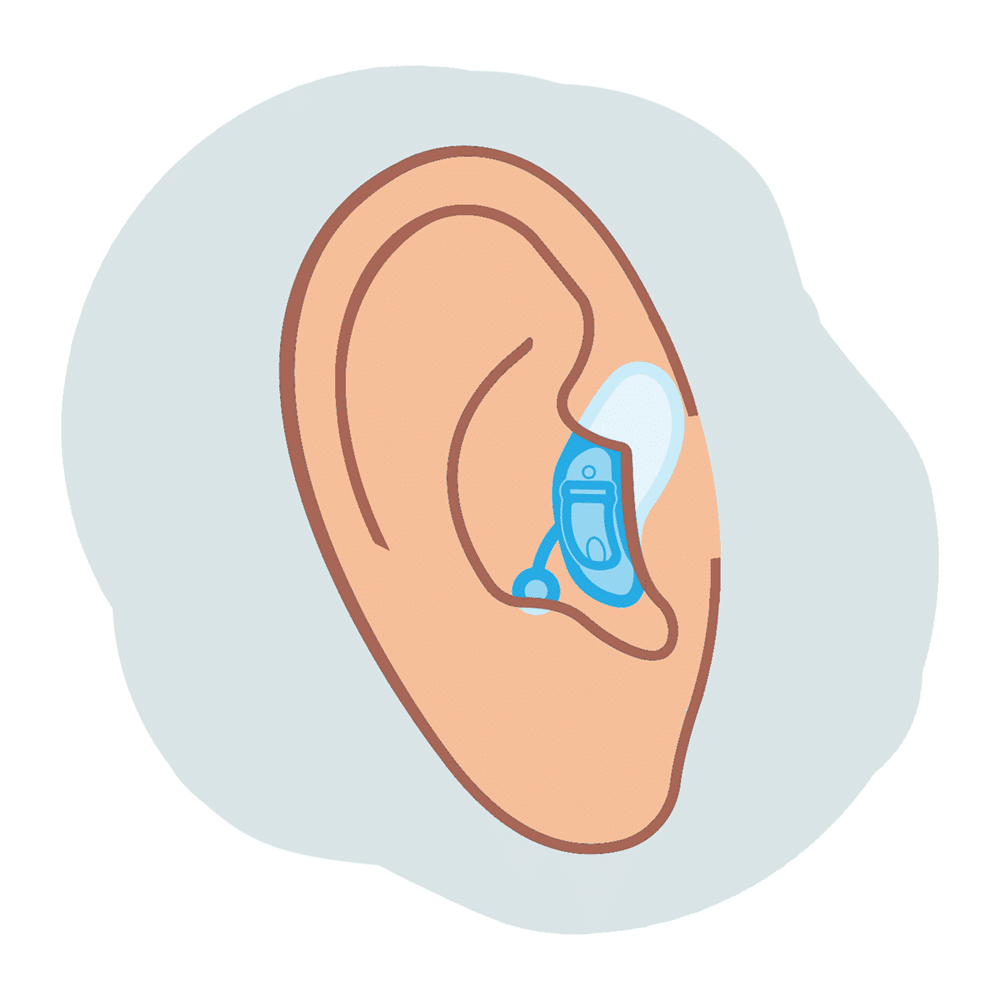
Also called a mini CIC, this hearing aid is the smallest and least visible device for treating hearing loss. It is positioned completely within the ear canal, and a tiny string allows you to remove the device.
In addition to an invisible fit, CIC devices offer the advantage of less feedback when using a telephone and less disruptive noise from wind.
Due to their small size, CIC hearing aids may not have some of the features you’d get with other larger devices, such as Bluetooth streaming and rechargeable batteries. Some CIC hearing aids are also too small for a directional microphone. Battery life may also be shorter due to the small size of the device, and ear wax and moisture can affect their function.
Of the brands and models covered in this review, the following companies offer CIC hearing aids:
- Eargo
- MDHearing
- Signia
- Starkey
- hear.com
One subtype of CIC hearing aid is the invisible-in-canal (IIC) style. The Phonak Lyric comes in this style. Sitting deep in the ear canal, IIC hearing aids are truly invisible when properly inserted.
In-the-canal (ITC) hearing aid
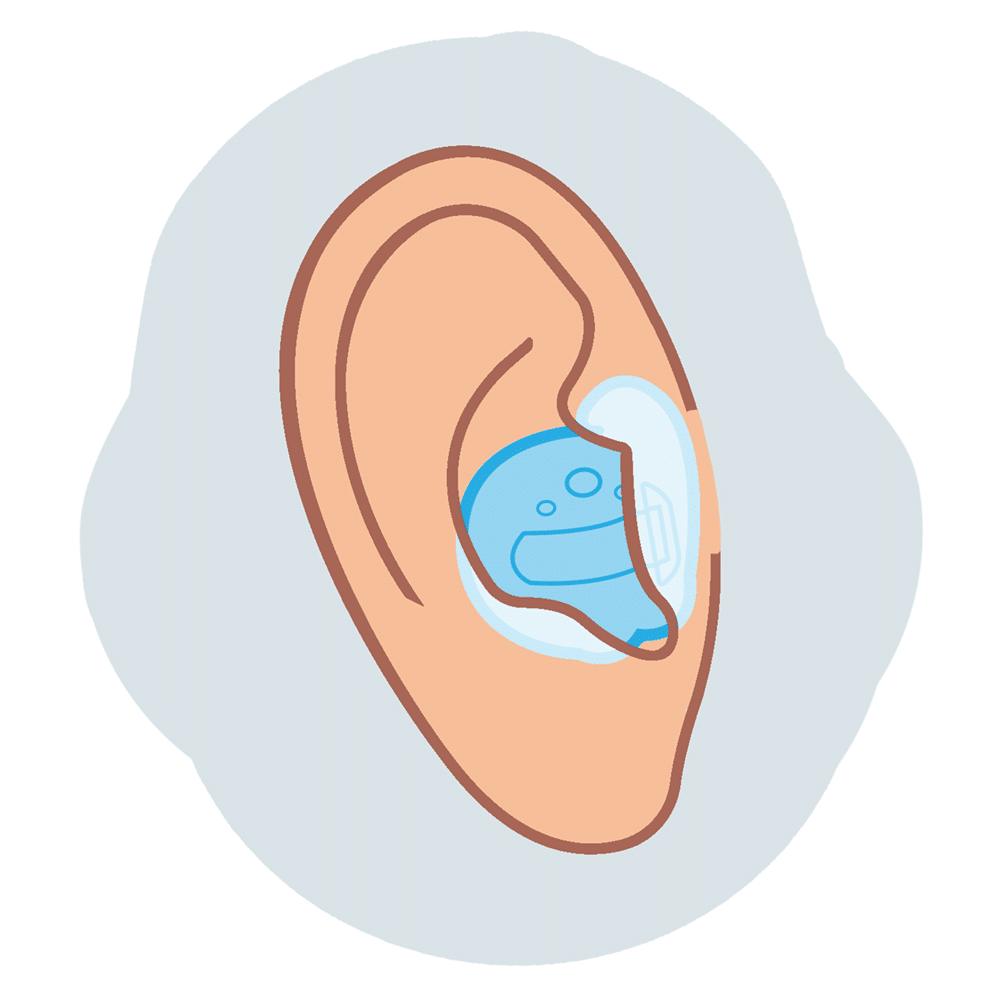
This hearing aid sits deep in the ear canal, but it’s a bit larger and more visible than a CIC device. ITC hearing aids allow for longer battery life than many CIC devices, as well as directional microphones. But they are still susceptible to issues with earwax and moisture, and may be difficult for some people to handle due to their relatively small size.
Behind-the-ear (BTE) hearing aid
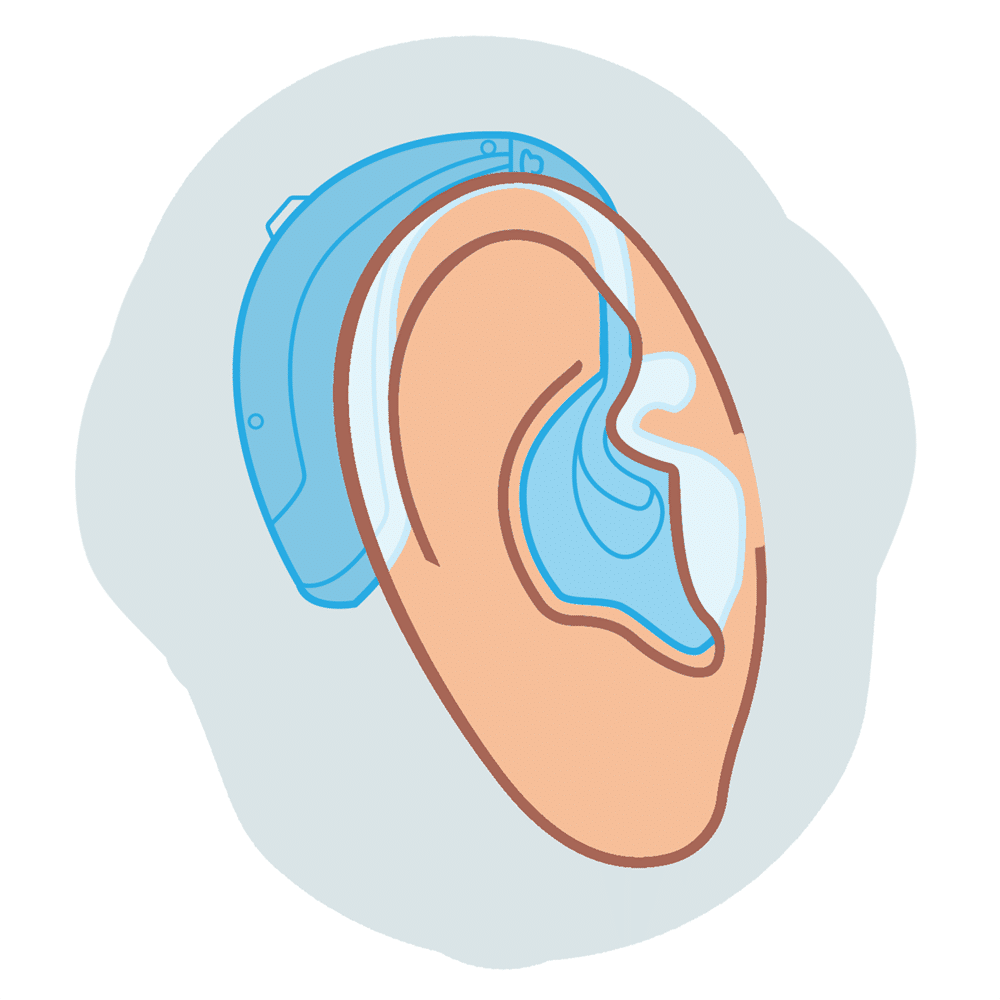
This device sits behind your ear and includes a plastic tube that hooks over your ear to reach the ear canal. At the end of the tube is a dome or custom-fit ear mold that sits snugly within the canal.
These devices tend to be larger than in-the-ear or in-the-canal hearing aids, but they offer more capabilities, such as directional microphones and a telecoil, which can help you hear better on the telephone and with assisted listening devices. They’re also easier to handle and can be a better choice for people with severe or profound hearing loss.
Of the brands and models covered in this review, the following companies offer BTE hearing aids:
- Lexie
- MDHearing
- Phonak
- Starkey
- hear.com
Receiver-in-canal (RIC) hearing aid
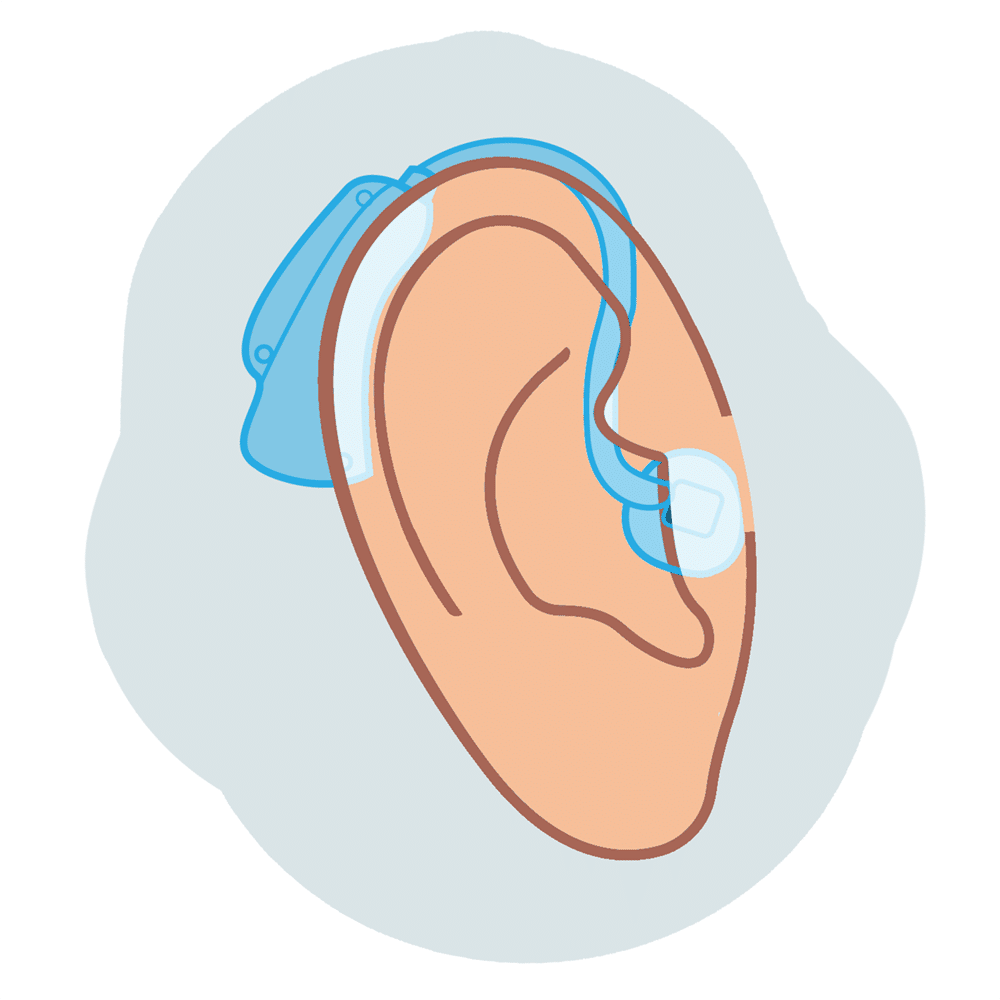
Also referred to as receiver-in-the-ear (RITE) or mini behind-the-ear (mBTE), RIC devices sit behind the ear like traditional types, but are smaller and less visible, especially when you choose one that matches your hair color. They have a tiny wire encased in silicone tubing that hooks over the ear and connects to a small receiver that fits inside the ear canal.
For many users, these devices strike the perfect balance between looks and functionality.
Of the brands and models covered in this review, the following companies offer RIC hearing aids:
- Jabra Enhance
- Lexie
- MDHearing
- Phonak
- ReSound
- Starkey
- hear.com
In-the-ear (ITE) hearing aid
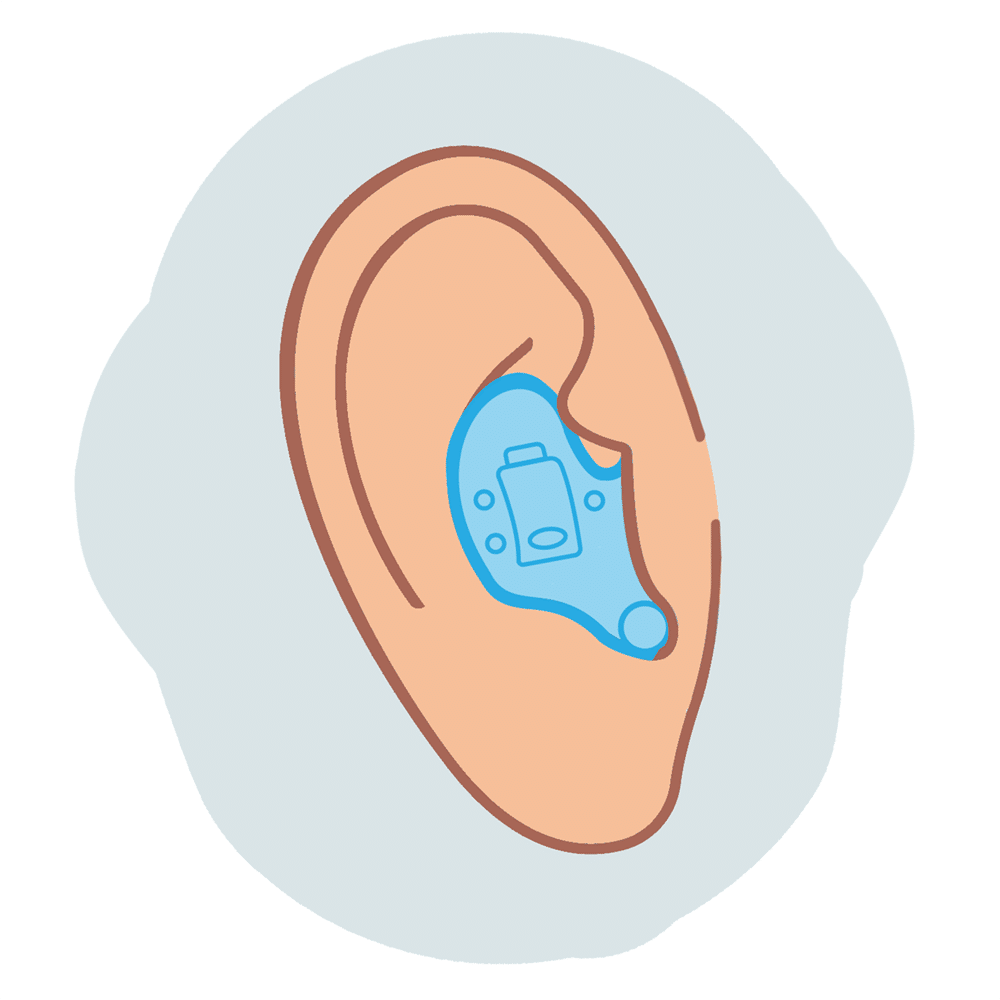
This type of hearing aid sits completely within the ear, but is larger than the CIC style. ITE hearing aids are generally large enough to offer advanced features such as Bluetooth, directional microphones, and a telecoil, but the smaller size may limit their power compared to BTE models. ITE hearing aids are typically easier to handle and insert than their smaller counterparts, but they may also be more visible.
Of the brands and models covered in this review, the following companies offer ITE hearing aids:
- Audien
- Starkey
- hear.com
Over-the-counter (OTC) hearing aids
In August 2022, the FDA established a new hearing aids category for OTC hearing aids. Consumers can now purchase certain hearing aids directly from pharmacies, stores, and online retailers—with no doctor visit or prescription required.
Based on the FDA’s final rule, [5]Federal Register. Medical Devices; Ear, Nose, and Throat Devices; Establishing Over-the-Counter Hearing Aids. Found on the internet at https://www.federalregister.gov/documents/2022/08/17/2022-17230/medical-devices-ear-nose-and-throat-devices-establishing-over-the-counter-hearing-aids OTC hearing aids:
- Are “intended to address perceived mild to moderate hearing loss in adults age 18 or older” [6]OTC Hearing Aids: What You Should Know. U.S. Food & Drug Administration. May 3, 2023. Found on the internet at https://www.fda.gov/medical-devices/hearing-aids/otc-hearing-aids-what-you-should-know
- Can be purchased online or in stores without a hearing exam, prescription, or professional fitting
The FDA’s final ruling on OTC hearing aids is meant to increase access. [7]Federal Register. Medical Devices; Ear, Nose, and Throat Devices; Establishing Over-the-Counter Hearing Aids. Found on the internet at https://www.federalregister.gov/documents/2022/08/17/2022-17230/medical-devices-ear-nose-and-throat-devices-establishing-over-the-counter-hearing-aids The high price of hearing aids, the perceived stigma of wearing them, and the concern that they aren’t effective are all common reasons that people with hearing loss wait an average of 10 years before seeking treatment. [8]Smith D, et al. Acceptability, benefits and costs of early screening for hearing disability: a study of potential screening tests and models. Found on the internet at https://www.journalslibrary.nihr.ac.uk/hta/hta11420/#/full-report This has paved the way for more retailers to enter the hearing aid market, which should drive the price down, making them affordable and shortening the wait time before people decide to treat their hearing loss.
Pros and cons of OTC hearing aids
If you’re not sure whether OTC hearing aids are right for you, it’s important to weigh the pros and cons. This can help you make the most informed decision when it comes to treating your hearing loss.
Pros and cons of prescription hearing aids
What to consider before buying a hearing aid
The National Institute on Deafness and Other Communication Disorders (NIDCD) reports that 37.5 million American adults have some level of hearing loss. [9]National Institute on Deafness and Other Communication Disorders. Quick Statistics About Hearing. Found on the internet at https://www.nidcd.nih.gov/health/statistics/quick-statistics-hearing While hearing loss can occur at any time in life, the problem becomes more common with age.
The NIDCD estimates almost one in four adults between the ages of 65 and 74 and half of people older than 75 have disabling hearing loss. Which is why it may come as a surprise that only one in three adults who could benefit from hearing aids has ever used them.National Institute on Deafness and Other Communication Disorders. Quick Statistics About Hearing. Found on the internet at https://www.nidcd.nih.gov/health/statistics/quick-statistics-hearing
People with hearing loss may not seek help for a variety of reasons, including:
- The cost of hearing aids and hearing care
- The fact that some insurance companies and Medicare plans do not cover hearing aids
- Distance from hearing care providers
- The stigma associated with wearing a hearing aid [10]The Gerontologist. The Stigma of Hearing Loss. Found on the internet at https://academic.oup.com/gerontologist/article/50/1/66/692298
We asked Michelle Brady, an audiologist with Access Audiology, a mobile audiology service in the New York City area, what she’d like people to know about the purchasing process. According to Brady, the most important thing to consider when shopping for a hearing aid is time.
“Research has shown that the longer hearing loss goes untreated, the [more the] brain’s ability to understand and decode speech decreases,” Brady said. “Just like muscles in the body—if you don’t use it, you lose it. Unfortunately, hearing aids cannot override the damage that occurs from years of decreased auditory stimulation. The earlier a patient gets hearing aids and wears them consistently, the better their brain will be able to process and decode speech.”
Hearing loss has also been associated with higher rates of falls, depression, and social isolation among older adults. Getting your hearing checked and corrected can play an important role in improving your quality of life.
What older adults look for in hearing aids
Older adults concerned with the visibility of a hearing aid should consider in-the-ear (ITE) models that are more discreet compared to behind-the-ear (BTE) options. Additionally, if you are not particularly tech-savvy or just want a hearing aid that has the easiest setup, it might be beneficial to consider a more basic hearing aid device without too many complex features. On the other hand, if you’re comfortable with smartphones, apps, and customizing your own settings, a more advanced model does offer more overall convenience in terms of operations.
Hearing aid features to consider
As hearing aid technology changes, more features become available. The following are a few of the most popular additional features that can make your hearing aids more helpful and enjoyable to use.
| Feature | Description |
|---|---|
| Bluetooth capabilities | When your smartphone is paired with your hearing aids using wireless Bluetooth technology, you can stream calls and audio from your phone or other device to your hearing aids. Bluetooth is a wireless technology that allows the exchange of information or data, in this case sound, between different devices. Smartphones have Bluetooth capability. Hearing devices with this feature can also connect to smartphone apps, allowing you to use your phone to adjust your hearing aid sound settings. |
| Directional microphones | Directional microphones help you understand conversations in noisy environments by making the sound in front of you louder than the sound coming from the rear or sides. Directional microphones work best when you are close to the sound source. |
| Feedback suppression | Feedback suppression in hearing aids helps to reduce high-pitched whistling sounds. It’s useful for minimizing feedback if you’re close to the telephone or if the hearing aid becomes slightly dislodged from your ear when you move your jaw. It can also allow for better sound quality for listeners who have good hearing in the lowest frequencies. |
| Digital noise reduction | Digital noise reduction improves listening performance in noisy environments by blocking out some background noise, making it easier to hear and understand speech. A majority of respondents to our survey said that digital noise reduction was the most important feature they wanted in a hearing aid. |
| Tinnitus masking | Hearing aids with a tinnitus masking feature minimize the ringing or buzzing sounds common in tinnitus by playing a variety of tones to help distract the brain. |
| Rechargeable batteries | Rechargeable hearing aid batteries allow you to recharge your devices instead of regularly buying new batteries and replacing them. The batteries don’t need to be removed from the hearing aids in order to charge them—you can place both hearing aids in a charging dock at night so they’re charged and ready to go in the morning. |
| Telecoil | A telecoil improves the ability to hear on telephones equipped with assistive listening technology and in facilities fitted with hearing loops. Most types of hearing aids have the telecoil option available. But due to their small size, CIC and IIC devices do not come with a telecoil. |
Common types of hearing loss
The type of hearing loss you have could influence the type of hearing aid you decide to purchase. Read on for information on the most common types of hearing loss. [11]Centers for Disease Control and Prevention. Understanding Hearing Loss. Aug. 7, 2023. Found on the internet at https://www.cdc.gov/ncbddd/hearingloss/parentsguide/understanding/understandinghearingloss.html
- High frequency: Trouble hearing sounds in the 2,000–8,000 hertz (Hz) range, which are many of the sounds involved in speech (most people with age-related hearing loss have problems hearing high frequencies.)
- Low frequency: Difficulty hearing sound frequencies of 2,000 Hz or lower
- Sensorineural: This is the most common type of age-related hearing loss and is caused by damage to the auditory nerve or hair cells in the inner ear
- Conductive: Caused by a problem with sound traveling through the outer or middle ear
- Mixed: A combination of sensorineural and conductive hearing loss
Degrees of hearing loss
Your degree of hearing loss can also impact the style of hearing aid that suits your needs. The CDC outlines four levels, or degrees, of hearing loss based on how loud sounds must be for you to hear and understand them. [11]Centers for Disease Control and Prevention. Understanding Hearing Loss. Aug. 7, 2023. Found on the internet at https://www.cdc.gov/ncbddd/hearingloss/parentsguide/understanding/understandinghearingloss.html
- Mild: Able to hear some speech, but softer sounds are difficult to hear
- Moderate: Unable to hear most speech at a normal level
- Severe: Unable to hear speech at all, can only hear some loud sounds
- Profound: Only able to hear extremely loud sounds
How much do hearing aids cost?
The cost of hearing aids largely depends on whether you’re purchasing OTC or prescription hearing aids, as well as the battery type (disposable or rechargeable), features, and sound technology. In fact, hearing aid pricing ranges widely: from $99 to $7,000.
How to find affordable hearing aids
Hearing aids are an investment. Even the most inexpensive hearing aids cost around $300 per pair.
MDHearing, for example, sells budget-friendly digital hearing aids starting at $999.98 per pair (before promotions). Audien offers low-cost devices starting at $99 per pair, but they’re very basic compared to other hearing aids on the market.
Before buying a lower-cost model, make sure to check the fine print. Some retailers and online distributors advertise low-cost hearing aids but are actually selling PSAPs, which amplify sound but do not provide the same level of support or technology as a hearing aid.
Hearing aids are typically sold through hearing care clinics or larger retailers, like Walmart or Costco. But you can also find inexpensive OTC hearing aids online through companies like MDHearing, Jabra Enhance, Lexie, and Eargo.
If you need a prescription hearing aid that’s only offered through a hearing care clinic, consider purchasing through an authorized discount supplier, such as Yes Hearing, which sells high-quality hearing aids, like Phonak and Signia, at a reduced cost. You still work with a local audiologist to get fitted and set up with your device, while the supplier manages the purchasing process with your hearing provider. This option could save you hundreds of dollars.
Read our review of the best affordable hearing aids for more in-depth guidance.
Does Medicare or insurance cover hearing aids?
Medicare Parts A and B don’t include coverage for hearing aids, although many Medicare Advantage Plans (known as Part C) and private insurance plans do provide hearing benefits. Contact your health care provider for more information.
NCOA continues to advocate for Medicare coverage of hearing aids by working with Medicare beneficiary groups and supporting H.R. 5376, the Build Back Better Act, which would initiate Medicare coverage for hearing aids.
In January 2023, U.S. representatives Debbie Dingell (D-MI) and Brian Fitzpatrick (R-PA) also reintroduced H.R. 244, the Medicare Hearing Aid Coverage Act, to Congress. Our Reviews Team spoke with Rep. Dingell’s office and learned that if the bill passes, it would remove a Social Security restriction on hearing aid coverage.

“Hearing aids aren’t a luxury, they are critical for millions of people to maintain a healthy, independent lifestyle. Without them, many seniors cannot interact with family, friends, neighbors, and their communities, and as a result, can become isolated.
“By expanding coverage for hearing aids under Medicare, more seniors will be able to live with dignity and independence. I’m proud to re-introduce this legislation, and remain committed to getting this signed into law to expand access to care for so many who need it. It’s simple: No one should feel isolated, confused, or shut out from the world because they can’t afford hearing aids,” said Dingell.
How to buy hearing aids
A few years ago, there was only one way to get treatment for hearing loss: Make a trip to a hearing care clinic to be tested and fitted for hearing aids. This was a challenge for many people who didn’t have easy access to these locations. But thanks to recent changes in the hearing aids industry, there are now multiple ways to purchase high-quality hearing aids.
Visit a hearing clinic
For prescription hearing aids, you will generally need to visit a hearing care clinic for an in-person consultation and hearing exam by an audiologist or hearing instrument specialist. Audiologists are hearing professionals with at least a master’s degree in the field of audiology who diagnose hearing loss and fit hearing aids. Hearing instrument specialists are hearing professionals with a high school diploma or two-year degree and are only licensed to help fit or program hearing aids.
Purchase prescription hearing aids through a discount network
Another option is to purchase prescription hearing aids from a discount network such as Yes Hearing for up to 40% less than retail price. When you purchase through this network, you’ll be connected with an audiologist in your area for further care. If you are a veteran, check with your local Veteran Affairs (VA) medical center about meeting with an audiologist, getting a hearing test, and determining which hearing aid is right for you.
Larger retail stores, such as Costco, also sell hearing aids. Almost 15% of the hearing aid users we surveyed used Kirkland hearing aids from Costco. The next most-popular brand in our survey was Eargo, with 8%.
Buy prescription hearing aids online
The newest way to buy prescription hearing aids is through a company like hear.com. Its Horizon line of hearing aids is offered through a unique Clinic-in-a-Box service, where you are sent everything needed for professional testing, fitting, and customization, all done at home through teleaudiology (virtual hearing care) and with the help of a hearing professional. This system allows people in rural areas or with limited transportation to access high-quality, prescription hearing aids.
Buying OTC hearing aids online
The ability to buy online hearing aids eliminates some of the barriers that can prevent people from seeking care for their hearing loss. Overall, the purchasing process is simple for many OTC hearing aids, but it’s important to know that buying hearing aids online isn’t for everyone.
In some cases, hearing loss may be caused by a medical problem such as diabetes, osteoporosis, or meningitis, and that can only be detected in a consultation with a medical doctor and an audiologist. Buying hearing aids without that intervention may let an underlying medical problem persist.
It’s also important to keep in mind that getting the right hearing aid for your needs depends on your specific type and severity of hearing loss. Hearing aids bought through a hearing clinic are programmed individually for each person according to the results of their audiogram (hearing test).
In-person vs. online hearing screenings
In-person hearing tests are much more detailed than online hearing screenings, because they include a physical exam of the ear and several tests to measure your ability to hear and understand various frequencies of speech and sound. Some OTC hearing aid companies, such as Jabra Enhance have an audiology team to interpret audiograms and program hearing aids, but others don’t.
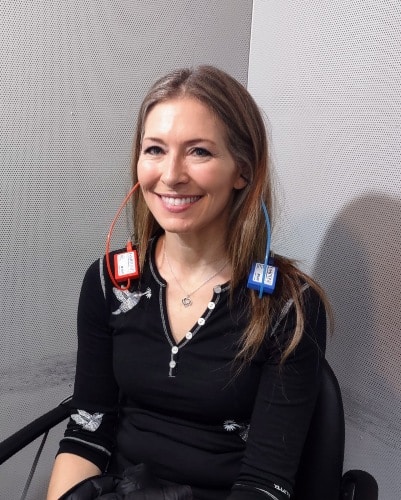
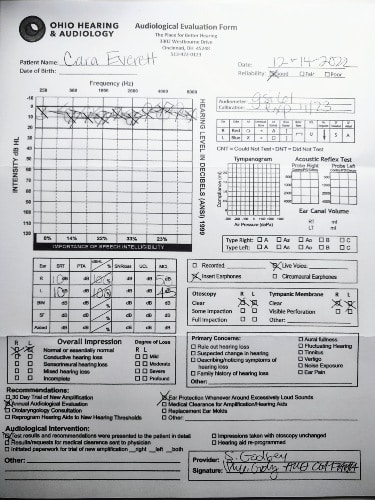
Keep in mind that some of the less expensive devices don’t have the detailed programming options necessary for many types of hearing loss. These include certain OTC hearing aids (including Audien) as well as personal sound amplification products (PSAPs), which are not true hearing aids. PSAPs make all sounds louder, but they aren’t able to target the specific frequencies where hearing loss has occurred or filter out background noise.
If you aren’t sure what type of hearing aid you need, speak with an audiologist or hearing aid specialist who can provide guidance.
Our reviews team interviewed Jacquelyn C. J. Lovitt, a practicing doctor of audiology, to help explain the costs associated with different types of hearing aids.
Buying OTC hearing aids
As mentioned above, many stores that carry health devices also sell OTC hearing aids. Check the list below to see if any of the following retail stores are in your area:
Best Buy
CVS
Walgreens
Walmart
Victra Verizon
You can also purchase hearing aids online from companies that offer quality OTC hearing devices at lower prices. Some OTC hearing aid manufacturers provide virtual consultations with an audiologist for personalized recommendations and adjustments along with your purchase.
Which is better: In-the-ear or behind-the-ear hearing aids?
Hearing aids come in several styles, including behind-the-ear and in-the-ear. Finding the best device for you depends on several factors.
A behind-the-ear (BTE) hearing aid sits behind your ear with a plastic earmold that fits into the outer ear. The case that sits behind your ear holds all the electronic parts necessary to make it work. BTE devices are bigger, so they are typically easier to use and handle, making them a good choice for kids and older adults.
They’re also able to hold a larger battery, which provides a longer battery life. Plus, the bigger size makes them more durable and able to provide more features. BTE hearing aids serve a range of ages and hearing loss. They are appropriate for all ages and work well for anyone with mild to profound hearing loss.
In-the-ear (ITE) hearing aids fit inside the ear, either partially or completely, and work well for mild to severe hearing loss. Some ITE devices come with a telecoil, which is a small magnetic coil enabling you to hear sound through the circuit rather than the hearing aid’s microphone.
Telecoils can improve the quality of phone conversations and help you hear in facilities equipped with hearing loops, like auditoriums and places of worship. ITE hearing aids are smaller than BTE or RIC devices, but they are still bigger than nearly invisible options like a completely-in-the-canal (CIC) or invisible-in-canal (IIC) hearing aid.
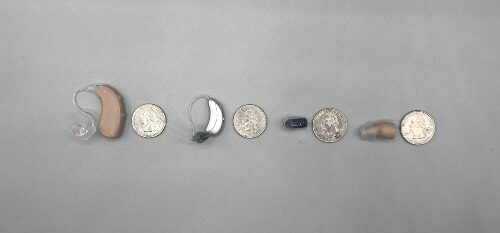
How to care for your hearing aids
Maintaining and taking care of your hearing aids will ensure they function properly and have a long battery life. You should clean your devices regularly, according to the manufacturer’s instructions, as substances like ear wax and fluids, including ear drainage, can cause damage to your hearing aids. You should also avoid moisture (especially if your devices are not water resistant), as well as high temperatures. It’s also best to remove your hearing aids when using hair products. When it comes to battery life, make sure you change disposable batteries as soon as they die and turn off your hearing aids whenever they are not in use.
The future of hearing aids
With so many advances in technology, it’s no surprise the future of hearing aids is especially bright. Manufacturers continue to innovate to offer consumers the best hearing solutions possible through state-of-the-art sound technology.
For example, according to the National Institute on Deafness and Other Communication Disorders, researchers are heavily invested in learning how to apply new signal processing tactics to hearing aids. Additionally, computer-aided technology systems are being utilized to improve design components. New ideations surrounding improved sound transmission and reduced background noise are also underway. [13]National Institute on Deafness and Other Communication Disorders. Hearing Aids. Oct. 11, 2022. Found on the internet at https://www.nidcd.nih.gov/health/hearing-aids
Still, studies focused on how to choose and fit hearing aids for certain groups of people, including children, are in the works, with scientists running directional microphone tests on the ear structure of a tiny fly.
Additionally, the use of Bluetooth connectivity continues to advance with major hearing aid makers because it improves our daily quality of life. Some brands offer multi-device streaming and connectivity so you can switch seamlessly from your smartphone to your television. It won’t be long before more brands implement better Bluetooth features, too. With Bluetooth and smartphones top of mind, we can expect a more upgraded smartphone app experience as well.
Plus, well-known hearing aid brands, like Starkey, Oticon, and Widex, are already using artificial intelligence (AI) features for auto-adjustment, user inputs, and to power natural sound. And it won’t be a surprise if big brand collaborations are in store from household names, like Apple and Samsung, which are already extremely sound-oriented.
The rise in popularity of telehealth services now includes hearing health care, too. When it comes to methods of shopping for hearing aids, we expect more companies to begin offering full-service in-home prescription hearing aids to consumers, with models similar to hear.com.
Frequently asked questions
There are five main types of hearing aids:
- Completely-in-canal (CIC): The smallest type, CIC devices sit completely within the ear canal, with a tiny string that hangs outside your ear so you can remove them easily.
- In-the-canal (ITC): These devices also sit in the ear canal, but are larger and a bit more visible than CICs.
- Behind-the-ear (BTE): BTE devices have an earmold that rests behind your ear, with a plastic tube that hooks over your ear and runs into your ear canal to transmit amplified sound.
- Receiver-in-canal (RIC): RIC devices, also known as receiver-in-the-ear (RITE) or mini behind-the-ear (mBTE), sit behind the ear like the BTE type, but are often smaller and less visible.
- In-the-ear (ITE): ITE devices sit completely within the ear like the CIC, but are larger, making them easier to handle but more visible.
According to our Reviews Team testing, Lexie was the second highest scored OTC hearing aid, right behind our “Top Pick” Jabra Enhance. Among prescription brands, Oticon earned the highest score for its advanced technology, variety of styles, and feature-rich smartphone app.
Jabra Enhance is our Reviews Team’s “Top Pick” for the company’s combination of quality, powerful devices, and ongoing customer support from an audiology care team (depending on the package you purchase). But keep in mind that the best hearing aid for you will depend on several factors, such as your degree of hearing loss, your lifestyle and preferences, and your budget.
Crackling, or static noise in your hearing aids, usually signals that your devices need maintenance—the battery may be low or there could be a buildup of moisture, earwax, or dirt in your hearing aid. When you hear a crackling, first try repositioning your hearing aids. If that doesn’t work, flush your ear canal with an earwax remover and clean your hearing aids thoroughly. If the problem persists, go to a hearing clinic or contact your device manufacturer for assistance.
Unless a doctor or audiologist has recommended hearing aids, you may not know if you need them. But if you’re noticing that you have trouble hearing in one or both ears, it may be time to consider hearing aids. Your spouse, other family members, and/or friends may have also noticed your difficulties with hearing and recommended hearing aids as a solution.
Some signs of hearing loss to be aware of, according to the Mayo Clinic, include: [14]Mayo Clinic. Hearing Loss. Found on the internet at https://www.mayoclinic.org/diseases-conditions/hearing-loss/symptoms-causes/syc-20373072
- Feeling the need to speak loudly
- Requiring audio devices to be turned up louder than normal
- Asking people to repeat themselves because you can’t hear or understand them
- Straining to hear
- Hearing better out of one ear
- Having difficulty hearing people on the phone
- Noticing that certain sounds and voices are muffled
If you’re experiencing any signs or symptoms of hearing loss, consider seeing an audiologist or hearing specialist. They can conduct a hearing exam to determine the degree of your hearing loss and provide a recommendation for different hearing aid styles and brands.
Even the most advanced hearing aids will not completely restore your hearing to its previous level. Instead, hearing aids are designed to maximize your hearing potential, especially in challenging listening situations.
Although they serve as an excellent tool to help retrain your brain to interpret sounds and filter others out, hearing aids can’t totally restore your hearing.
Hearing aids either use a rechargeable battery that comes with the hearing aid or a standard disposable battery. If the hearing aids use disposable batteries, make a note of the size. In general, standard hearing aid batteries come in four sizes: 10, 13, 312, and 675. You can purchase hearing aid batteries at pharmacies, retail stores, or directly from the hearing aid company.
Most rechargeable batteries are unique to the hearing aid. If you need a new rechargeable battery or charger, buy it directly from your hearing aid company.
You can have hearing loss in one or both ears. But most people have hearing loss in both ears. If you are in this category, experts recommend that you wear bilateral hearing aids—one in your left ear and one in your right ear. [15]Harvard Health Publishing. One Hearing Aid or Two? Found on the internet at https://www.health.harvard.edu/diseases-and-conditions/one-hearing-aid-or-two
Your brain receives signals from both ears, so it’s easier to process the noise into sound if it is getting information from both ears. However, many hearing aids can be programmed separately to accommodate the loss in each ear.
In-the-ear (ITE) hearing aids are custom-made devices designed to fit inside the ear, either partially or completely, and are suitable for individuals with mild to severe hearing loss. These hearing aid styles are less bulky than behind-the-ear (BTE) styles, but still larger and more noticeable than completely-in-the-canal (CIC) hearing aids.
While ITE devices are generally easier to insert, handle, and control than CIC styles, they do require an adjustment period. Some people experience discomfort during the first few weeks of use, often because they are new to wearing hearing aids, but also because they’ve become accustomed to the way other hearing aid styles feel in their ears, especially BTE styles. With time, most people find ITE styles comfortable and easy to wear.
In-the-ear hearing aids may come with a larger variety of features than smaller, nearly invisible devices are able to provide because they have more room for technology inside their casings, like telecoil for enhanced sound during phone conversations and public events. But they also have some drawbacks. ITEs may require more frequent cleaning due to earwax buildup, and are more prone to feedback issues than some models. ITE styles are not recommended for young children or those with profound hearing loss.
Adjusting to your new hearing aids takes time. For some people, getting used to wearing hearing aids happens within a few days. For others, there is an adjustment period that may take a few months.
In general, you should notice a difference right away. If you’re having problems, contact the hearing center or online retailer that sold you the hearing aids. They can provide tips and guidance to help with the fit and improve your hearing aid experience.
All hearing aids work to some degree. The style, size, and features determine how well they work for each type of hearing loss.
The advantage of small hearing aids is the almost invisible appearance they provide. Research shows that many people, especially older adults, associate hearing loss and hearing aids with stigma related to perceived feelings of lower cognitive ability, ageism (that hearing aids or hearing loss make them feel older), and vanity (that hearing aids or hearing loss make them look older).
Because they go in your ear, smaller hearing aids may not be a good fit for everyone’s ear canal. That’s why it’s a good idea to go to a professional to get fitted. Small hearing aids may also require more battery changes since they can only hold a small battery, and the compact size may result in fewer features.
If you buy one single hearing aid, the average cost is about $2,300, with the full range at $1,000–$4,000. For more severe hearing loss, the price of one hearing aid can cost up to $6,000.
Hearing aids are a substantial investment, and finding an affordable hearing device is a high priority for many people. Most companies offer several models at different prices.
If you’re looking for a hearing aid brand that consistently sells lower-priced products, MDHearing and Audien are both great places to start. In general, MDHearing devices range in price from $200–$800 for a single hearing aid and $400–$1,000 per pair. Audien carries even lower-priced hearing devices, ranging from $99–$249 per pair.
Visit NCOA’s Hearing Health page for more resources on hearing health for older adults.
If your doctor orders a hearing exam to determine whether you have hearing loss, the exam will be covered by Medicare Part B. This hearing test will help you figure out whether you need a hearing aid. But neither Medicare Part A or Medicare Part B (also known together as Original Medicare) will cover the cost of your hearing aids. Original Medicare also doesn’t provide coverage for routine hearing tests, fittings, or adjustments.
Although Medicare Part D doesn’t cover the cost of hearing aids, some Medicare Advantage plans (also known as Medicare Part C) do provide partial coverage. If you’re not familiar with Medicare Advantage plans, these are alternate ways of receiving Medicare coverage through private insurance companies, in place of Medicare Part A and B.
While Medicare Advantage plans may offer additional services, such as vision, dental, or hearing coverage, you might be restricted to a local coverage area. It’s important to understand what the Medicare Advantage plans cover and don’t cover before you make a decision during the Medicare open enrollment period.
For more help navigating Medicare, see the Medicare Guidance section of NCOA’s Age Well Planner. With in-depth information on Medicare basics, coverage, costs, and more, it’s a great resource for getting the most benefits out of your Medicare plan.
NCOA continues to advocate for Medicare coverage of hearing aids. NCOA also encourages you to contact your members of Congress to urge them to add hearing aid coverage to Medicare. To find out who your member of Congress is and how to contact them, visit house.gov to Find Your Representative.
The best hearing aids are those customized to your specific hearing loss, lifestyle, and preferences. Consulting with a hearing care professional, like an audiologist, is crucial to assess your hearing and recommend suitable options that are within your budget.
Consider your daily environment, occupation, and desired features. The right hearing aid should fit comfortably enough to wear all day. Ultimately, the best hearing aid is one you’re willing to wear consistently, enhancing your daily life without discomfort.
Proper maintenance is essential in extending the life of your hearing aid. Some tips include cleaning as instructed by the manufacturer, keeping the device away from moisture and out of the heat, not using hair styling products while wearing your hearing aid, and keeping small devices and batteries away from children or pets. Additionally, make sure to replace disposable batteries in a timely manner and turn off your device when it’s not being used.
On average, hearing aids last about three to seven years. How well you maintain your hearing aids will impact their lifespan, but it also depends on their construction and how much wear and tear they experience from being worn each day.
Adjusting to hearing aids takes patience. The transition can take a few days to several months, so give yourself time to adapt, and visit your hearing-care professional for adjustments as needed. It’s important to remember that hearing aids aren’t able to restore your hearing to its original state but to enhance it. Hearing professionals advise users to wear their hearing aids as often as possible and in different settings, whether watching TV at home, walking in the neighborhood, or dining in a busy restaurant, to help your brain readjust to the sounds it was missing.
If you find the adjustment period challenging, schedule a follow-up with your hearing specialist. They can tweak your device settings or suggest a different style that better suits your needs. Remember, even a minor adjustment to your hearing aids can make a significant difference in comfort and performance.
Costco hearing aids are often more affordable than other retailers due to Costco’s business model. They can offer lower prices by buying hearing aids in bulk directly from manufacturers. Costco then sells hearing aids to members at a discounted rate. Learn more about the best Costco hearing aids, including features and pricing.
Have questions about this review? Email us at reviewsteam@ncoa.org.
Sources
- Centers for Disease Control and Prevention. Facts About Falls. Found on the internet at https://www.cdc.gov/falls/facts.html
- John Hopkins Medicine. Hearing Loss Linked to Three-Fold Risk of Falling. Feb. 27, 2012. Found on the internet at https://www.hopkinsmedicine.org/news/media/releases/hearing_loss_linked_to_three_fold_risk_of_falling
- Rock Health. Consumer Adoption of Digital Health in 2022: Moving at the Speed of Trust. Feb. 21, 2023. Found on the internet at https://rockhealth.com/insights/consumer-adoption-of-digital-health-in-2022-moving-at-the-speed-of-trust/
- U.S. Food and Drug Administration. Types of Hearing Aids. Found on the internet at https://www.fda.gov/medical-devices/hearing-aids/types-hearing-aids
- Federal Register. Medical Devices; Ear, Nose, and Throat Devices; Establishing Over-the-Counter Hearing Aids. Found on the internet at https://www.federalregister.gov/documents/2022/08/17/2022-17230/medical-devices-ear-nose-and-throat-devices-establishing-over-the-counter-hearing-aids
- OTC Hearing Aids: What You Should Know. U.S. Food & Drug Administration. May 3, 2023. Found on the internet at https://www.fda.gov/medical-devices/hearing-aids/otc-hearing-aids-what-you-should-know
- National Institute on Deafness and Other Communication Disorders. Over-the-Counter Hearing Aids. Found on the internet at https://www.nidcd.nih.gov/health/over-counter-hearing-aids
- Smith, D, et al. Acceptability, Benefits and Costs of Early Screening for Hearing Disability: A Study of Potential Screening Tests and Models. November 2007. Found on the internet at https://www.journalslibrary.nihr.ac.uk/hta/hta11420/#/full-report
- National Institute on Deafness and Other Communication Disorders. Quick Statistics About Hearing. Found on the internet at https://www.nidcd.nih.gov/health/statistics/quick-statistics-hearing
- Wallhagen, Margaret. The Stigma of Hearing Loss. The Gerontologist. February 2010. Found on the internet at https://academic.oup.com/gerontologist/article/50/1/66/692298
- Centers for Disease Control and Prevention. Understanding Hearing Loss. Aug. 7, 2023. Found on the internet at https://www.cdc.gov/ncbddd/hearingloss/parentsguide/understanding/understandinghearingloss.html
- Mayo Clinic. Hearing aids: How to choose the right one. Found on the internet at https://www.mayoclinic.org/diseases-conditions/hearing-loss/in-depth/hearing-aids/art-20044116
- National Institute on Deafness and Other Communication Disorders. Hearing Aids. Oct. 11, 2022. Found on the internet at https://www.nidcd.nih.gov/health/hearing-aids
- Mayo Clinic. Hearing Loss. Found on the internet at https://www.mayoclinic.org/diseases-conditions/hearing-loss/symptoms-causes/syc-20373072
- Harvard Health Publishing. One Hearing Aid or Two? Found on the internet at https://www.health.harvard.edu/diseases-and-conditions/one-hearing-aid-or-two








